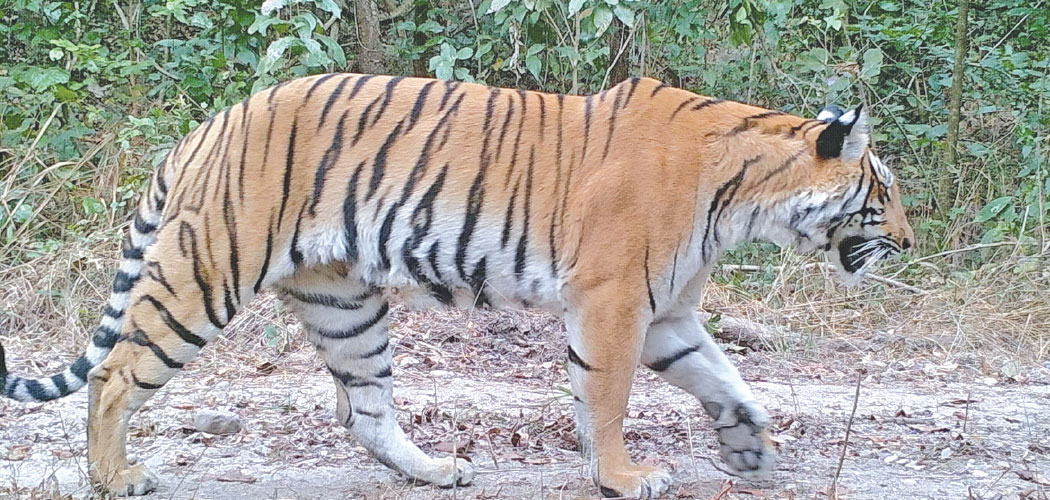
SATV 19 April, Kathmandu: Madhes Province hosts 163 species of fish, 24 species of amphibians, 95 reptile species and 578 species of birds. But they are now under threat due to human-wildlife conflict, habitat loss, illegal hunting and environment degradation, a latest study said.
Rich in biodiversity, with a wide range of vertebrate species including fish, amphibians, reptiles, birds and mammals, these creatures are increasingly under threat, particularly outside the protected areas, said the study conducted between 2022 and 2024.
The study team including Dr. Hari Prasad Sharma, Associate Professor at the Central Department of Zoology, Tribhuvan University, recorded 163 species of fish in major river systems such as the Bagmati, Lal Bakaiya, Triyuga and Kamala.
Nine species were recorded in the province for the first time, including Anabas cobojius and Garra mullya. While most fish were listed as “Least Concern” on the IUCN Red List, the presence of endangered species such as Tor putitora raises conservation concerns, said Dr. Sharma.
According to the study released on Friday, in the amphibian category, researchers recorded 24 species, with Dicroglossidae being the dominant family. Among them, Amolops mahabharatensis was listed as vulnerable, and three new frog species were recorded in the province.
Likewise, 95 reptile species were identified, including snakes, turtles and crocodiles. The spectacled cobra was the most frequently observed reptile, while two crocodilian species-- the mugger and gharial-were also recorded, signalling the ecological richness of river and wetland habitats.
Sharma said that the province also hosts 578 bird species -- about 64 per cent of Nepal’s total bird population. Forest areas showed the highest bird diversity, especially in winter. Although the bird diversity index was high, 28 species were listed as globally threatened, with six considered critically endangered. Nationally, 102 species fall under the threatened category.
The illegal trapping and sale of farmland birds, especially during winter, was identified as a serious issue, with more than 100,000 birds reportedly hunted each year and sold under the name “Bagedi.”
The mammal survey recorded 90 species, with the highest diversity in the Carnivora order, followed by rodents and bats. Twenty-two mammal species were found to be globally threatened, and 31 were nationally threatened.
New records included bat species and rodents such as Rattus tanezumi. The presence of large carnivores like tigers and leopards was confirmed, though leopard occupancy was found to be low, except in areas close to Parsa National Park, the research said.
“Human-wildlife conflict is a growing problem across the province. Nearly 68 per cent of people surveyed reported frequent wildlife visits to their communities, particularly wild boars, blue bulls and monkeys. These animals often raid crops or harm livestock,” Sharma said.
Residents identified proximity to forests, habitat degradation and rising wildlife populations as key causes of conflict. Although most community members said they do not support killing wildlife, citing legal and religious reasons, losses from conflict are significant, and government compensation is often delayed or inadequate.
Another issue raised in the study is the high incidence of snakebites. Between 2014 and 2024, almost 30,000 snakebite cases were reported in the province, most of them non-venomous. The highest number of cases occurred between 2018 and 2020.
The study also recommended urgent steps to conserve biodiversity. The recommendations include -- controlling illegal hunting and bird trapping, restoring wetlands, improving fire management and simplifying the compensation process for conflict victims.
It also suggested developing wildlife corridors between Chitwan National Park and Koshi Tappu Wildlife Reserve via key rivers and promoting wildlife-friendly infrastructure such as safer roads and bridges.
Conservationists also urged cross-border cooperation with India to manage mobile species, and called for the relocation of species like the blue bull from farmlands to protected areas. In addition, raising awareness through community education and incorporating conservation into school curricula are seen as vital long-term solutions.
The province’s biodiversity is both a natural treasure and a critical resource for local livelihoods. Without timely action, many of its species and ecosystems could face irreversible damage, said the study, calling for science-based policies, strong enforcement, and active community involvement to protect the province’s wildlife for future generations.
Other members of the research team include Dr. Bishnu Prasad Bhattarai Central Department of Zoology, TU, Dr. Hem Bahadur Katuwal, Nepal Zoological Society, Kathmandu, Nepal and Dr. Sabina Koirala, Nepal Zoological Society, Kathmandu, Nepal.
The research was conducted with the financial support of the Research Coordination and Development Council, Tribhuvan University, Kirtipur, Kathmandu.












